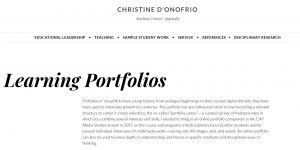Programs were targeted based on these criteria:
- multimedia and multimodal student production (e.g. Media Studies and Geographic Information Systems)
- professional preparation (e.g. School of Library, Archival, and Information Science)
- the need to communicate with an external audience (e.g. First Nations and Indigenous Studies)
- existing co-curricular activities in courses (e.g. Political Science, Sociology)
These programs were seen as fertile ground for the use of eportfolios in courses so they were contacted and we asked for instructors who would be keen to work with the team on student training and information sessions, attend faculty training workshops, and assess student portfolio work
Pilot implementation of e-portfolios in some Arts undergraduate courses:
- 2015-16: 3 Geography courses
- 2016-17: 2 Classics/Philosophy courses, 2 First Nations and Indigenous Studies courses, 1 Visual Arts course
- 2017-18:2 Italian courses and in the Masters of Library & Information Studies
The project hoped to get eportfolios entrenched in the curriculum of these programs. However deliberations in the programs took place slowly and unevenly and this outcome was not achieved.
Next: 5. The Limits of Curricular Integration of Eportfolios

We learned that despite the obvious fit of eportfolios in programs and courses, it requires an unusual level of interest and commitment from faculty members to change their course design to include eportfolios. No one faculty member feels the responsibility to include in their course some modules on reflection, translating disciplinary expertise to the 'real world', and mapping life paths beyond university. Indeed we discovered faculty rather reticent to play this role, as they rightly argue they are not trained to do so.
These experiences led us to look to the Faculty level to address some of these issues and this led to the creation of a Faculty of Arts working group in 2018-19 to explore curricular options outside of departments and programs.